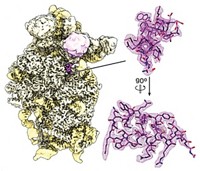Advertisement
Grab your lab coat. Let's get started
Welcome!
Welcome!
Create an account below to get 6 C&EN articles per month, receive newsletters and more - all free.
It seems this is your first time logging in online. Please enter the following information to continue.
As an ACS member you automatically get access to this site. All we need is few more details to create your reading experience.
Not you? Sign in with a different account.
Not you? Sign in with a different account.
ERROR 1
ERROR 1
ERROR 2
ERROR 2
ERROR 2
ERROR 2
ERROR 2
Password and Confirm password must match.
If you have an ACS member number, please enter it here so we can link this account to your membership. (optional)
ERROR 2
ACS values your privacy. By submitting your information, you are gaining access to C&EN and subscribing to our weekly newsletter. We use the information you provide to make your reading experience better, and we will never sell your data to third party members.
Infectious disease
Covid-19
Electron microscopy reveals coronavirus replication structure
Membrane-spanning protein complex may provide important exit route for replicated viral RNA
by Celia Henry Arnaud
August 12, 2020
| A version of this story appeared in
Volume 98, Issue 31

Coronaviruses, such as SARS-CoV-2, replicate their RNA genomes inside compartments they build within the cells they infect. The most abundant components of these so-called replications organelles are RNA-containing double-membrane vesicles (DMVs). Previous studies of these DMVs suggested that they are sealed, leading to questions about how the replicated RNA gets out to form new viral particles.
Support nonprofit science journalism
C&EN has made this story and all of its coverage of the coronavirus epidemic freely available during the outbreak to keep the public informed. To support us:
Donate Join Subscribe
Montserrat Bárcena and Eric J. Snijder of Leiden University Medical Center and coworkers have discovered that the DMVs might not be closed after all. Using cryo-electron tomography, they have identified a previously unknown molecular pore in the DMV (Science 2020, DOI: 10.1126/science.abd3629). This pore could be a target for therapies that block the replication of coronaviruses.
To find the pore, the researchers used a different strategy from the ones typically used to image structures inside cells. Fixing cells, embedding them in resin, and slicing them does a poor job of preserving macromolecuar features like the molecular pore. Bárcena and coworkers instead flash-froze cells infected with a coronavirus and used a focused ion beam to sculpt a 150–200 nm slice. “This approach is extremely powerful, as our study shows, but also time-consuming and technically demanding,” Bárcena says.
The researchers found a macromolecular pore complex of about 3 megadaltons that spans both membranes of the DMV. The cryo-electron tomography images reveal that the complex has a crown-like structure with sixfold symmetry on the outside of the DMV. By attaching protein labels that add extra mass, which can be seen in the electron microscopy, the researchers established that the main component of the pore complex is the virus’s nonstructural protein 3 (nsp3). Because of the complex’s large size, they think nsp4 and nsp6 are also part of the membrane-spanning region of the complex.
To avoid biosafety problems and the need for deactivating agents with SARS-CoV-2, the researchers instead used murine hepatitis coronavirus, which is a well-studied model virus from the same genus. “While we don’t have a 3-D model yet for the SARS-CoV-2 pore, we expect the two structures to be comparable,” Bárcena says. “These are both betacoronaviruses and nsp3, the main component of the complex, is very similar.”
The work “opens up new avenues for antivirals,” says Benjamin Neuman, a virus expert at Texas A&M University-Texarkana. “Clogging the pathway in and out of the DMV now appears to be a viable antiviral strategy.”
“We have just unraveled this pore and need a lot more work to understand how it works, so it will take time before we can figure out how to interfere with it,” Bárcena says. But it could help with future pandemics. One thing we should have learned from these past 2 decades, she says, “is that zoonotic coronavirus outbreaks are bound to keep on occurring and creating serious public health problems.”





Join the conversation
Contact the reporter
Submit a Letter to the Editor for publication
Engage with us on Twitter